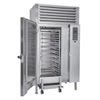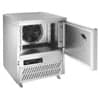Blast Chillers
A blast chiller rapidly removes heat from recently cooked products, enabling items to be placed into a refrigerator for short- or long-term storage. Blast chillers are also frequently used by dessert and pastry chefs to quickly cool ingredients being paired with cold food. More

These record data like food temperatures and the time it takes to cool them to appropriate levels to ensure safe holding.

These units have one or more probes that can be inserted into food to track temperatures and ensure proper chilling.
Choosing the right blast chiller or blast freezer will depend primarily on the volume of food you need to chill at one time, and how often you intend to do so. Small, undercounter models are available that will chill a few dozen pounds at once, while very large roll-in models can chill several full-pan-racks worth of product.
Blast chillers are designed to accommodate full-size, 12-in. x 20-in. x 2-1/2 in. steam table pans. Each full-size pan can hold about 10 pounds of product, so a good way to size your new unit is to understand how many pounds of food you want to chill at once, divide that by ten, and you'll know how many pans your new unit needs to accommodate. It is important not to overload this equipment because doing so can slow down the chilling process, meaning that the food might not reach the desired temperatures in time to avoid the development of foodborne bacteria. Also take into account other uses for the chiller; many operators use theirs to chill salad plates and bottled drinks.
Type
The type of flash freezer or cooler you choose will depend on the volume of food you will need to chill at once. A floor model reach-in unit will hold around 10 to 24 pans, letting you chill a few hundred pounds of food at once. The largest roll-in equipment will accommodate several racks, chilling thousands of pounds of product.
Facilities that only need to chill a few pans at a time can save some space with a smaller countertop or undercounter unit. These typically hold 3 to 4 pans at once.
Compressor Location
Top-mounted compressors tend to stay cleaner because they don't take in dirt and debris from the floor, although service calls can take a little longer because they're harder to access and may require two service technicians. Bottom-mounted compressors are easier to access, but placement near the floor means they might need to be cleaned more frequently.
Side-mounted compressors are mounted in the right or left of the equipment. These have the advantage of being easy to access and service, but they add to the horizontal space requirements of the blast chiller because they need to be able to intake and exhaust air for cooling the coils. That means they may not be an ideal choice for space-limited kitchens.
A blast chiller compressor is generally larger than those on other refrigerated equipment because of the need to bring the temperature down quickly to safe holding levels. For that reason, they will produce more noise and heat. A remote refrigeration system, installed on the roof or outside your building, can put that heat and noise outside instead of in your kitchen, creating a more comfortable working environment.
Specialty Options
- Some blast freezers include probes that can be inserted into food to ensure it's reached the desired temperature.
- To prevent costly breakdowns, auto defrost features melt ice that naturally collects on the coil.
- Programmable models allow the user to input time and temperature cycles for individual products and quantities. These can be recalled each time that particular product needs to be chilled. This reduces operator error and provides more consistent results.
- HACCP record keeping features will monitor and track temperatures in your equipment to ensure that food gets chilled fast enough, keeping your operations within HACCP guidelines.
- A model with a removable rack can make cleaning the inside of the unit easier.
- The largest models allow you to roll in pan racks full of pans.
- Pass thru models have doors on both sides so pans can be put in one side and removed through the other. This is particularly useful in kitchens where the cook line and the rest of the operation are separated because it allows the cook to put the food into the unit in the hot area, then unload it in a cooler area.
- Networkable models include Ethernet connections for receiving alarm notifications and managing equipment remotely.
- Sometimes called a flash freezer or blast freezer, many of these models include a freezer holding feature that will take foods to freezing and store them until you're ready to remove them.
- The largest, multi-rack roll-in blast chiller units can accommodate up to three full racks at once.
More information on blast freezers and how they work is covered in this introduction to blast chillers.
